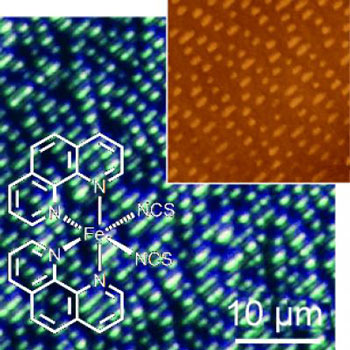Ein internationales Forscherteam, dem auch LMU-Wissenschaftler angehoeren, konnte nun zeigen, dass Defekte in den Nanoroehren das Material sogar verbessern koennten.
Oct 28th, 2008
Read more
Harnessing the process of biomineralization may be closer to reality as an international team of scientists has detailed a key and previously hidden mechanism to transform amorphous calcium carbonate into calcite, the stuff of seashells.
Oct 27th, 2008
Read more
A new nanoparticle-enabled imaging method for breast cancer, utilizing encapsulated fluorescent molecules in calcium phosphate nanoparticles and nontoxic near infrared imaging, has been developed by a team of scientists from Penn State.
Oct 27th, 2008
Read more
By coupling a kicked-up version of microscopy with gold nanoparticles, investigators at Duke University have been able to peer so deeply into living tissue that they can see molecules interacting.
Oct 27th, 2008
Read more
Nanoparticles filled with small interfering RNA (siRNA) molecules targeting two genes that trigger melanoma have shown that they can inhibit the development of melanoma, the most dangerous type of skin cancer.
Oct 27th, 2008
Read more
A team of investigators at Northwestern University has developed a promising nanomaterial-based biomedical device that could be used to deliver chemotherapy drugs locally to sites where cancerous tumors have been surgically removed.
Oct 27th, 2008
Read more
Thanks to the development of a microscope capable of measuring Raman spectroscopic signals from living mice, researchers have a noninvasive tool to study where carbon nanotubes travel once they are injected into the blood stream.
Oct 27th, 2008
Read more
Production capacity at the Solar Village is to be increased five times, with KACST and IBM working together to use nanotechnology to develop the Solar Village and improve its performance, with an agreement made to focus on new materials for converting solar energy into electricity.
Oct 27th, 2008
Read more
The World Economic Forum, in partnership with the Government of Dubai, will hold its inaugural Summit on the Global Agenda in Dubai from 7 to 9 November 2008.
Oct 27th, 2008
Read more
Synthetic biology is an emerging area of research that uses advanced science and engineering to make or redesign living organisms, such as bacteria, so that they can carry out specific functions.
Oct 27th, 2008
Read more
 In this information age, increased storage capacity is a central challenge for science and technology. A team of German and Italian researchers has pursued this by exploring the concept of 'nanostructured storage domains'.
In this information age, increased storage capacity is a central challenge for science and technology. A team of German and Italian researchers has pursued this by exploring the concept of 'nanostructured storage domains'.
Oct 27th, 2008
Read more
The Nano Science and Technology Institute (NSTI), and the Clean Technology and Sustainable Industries Organization (CTSI), today announced that the 2009 TechConnect World Conference and Expo will take place May 3-7, 2009 at the George R. Brown Convention Center in Houston, Texas.
Oct 27th, 2008
Read more
The University of Utah has announced that the Sorenson Legacy Foundation has made the lead donation of $15 million to begin constructing a sophisticated 193,000-sq. ft. biomedical and neurosciences building designed to help create and develop the next wave of health sciences technology.
Oct 27th, 2008
Read more
Computer scientists and engineers -- and one neurophysiologist -- met at Cornell Oct. 12-14 for a Symposium on Computing Challenges sponsored by the Kavli Institute at Cornell for Nanoscale Science.
Oct 24th, 2008
Read more
The International Safety Equipment Association (ISEA), in cooperation with the National Institute for Occupational Safety and Health (NIOSH), will sponsor a symposium Nov. 11, 2008, to examine the hazards workers will face and how they will be protected 25 years from now - in ISEA?s centennial year.
Oct 24th, 2008
Read more
From mitigating the causes of global warming to designing proteins for the treatment of diseases, researchers at the University of Pittsburgh will now be able to increase their potential for faster, more efficient and effective real-world solutions through the University's Center for Simulation and Modeling.
Oct 24th, 2008
Read more


 Subscribe to our Nanotechnology News feed
Subscribe to our Nanotechnology News feed